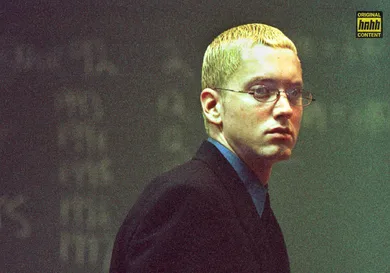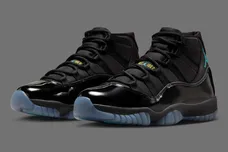Sequels are tricky. True, it’s become increasingly common to see modern rappers firing off a “part two” with little to no thematic significance to the first part, but every so often, a rapper surprises the masses with an unexpected sequel announcement. And the longer the wait between installments, the more heightened the suspense inevitably becomes. For Eminem, that moment of reckoning came in 2013, when he revealed he would be delivering The Marshall Mathers LP 2, a decision that immediately sparked cautious optimism in his fanbase. The esteemed reputation of its counterpart is well documented. Questions of cohesion immediately emerged; how was the sequel meant to continue to groundwork the original had built?
At first, it’s difficult to place where Eminem is going on the introductory song “Bad Guy,” produced by the team of S1, M-Phazes, StreetRunner, and Vinny Venditto. His opening bars are abstract enough to appear universal; given how frequently Em has looked inwardly to voice his own insecurities, it’s easy to assume that he’s voicing displeasure at his own self-destructive behavior. Though the sense that something greater is at play does loom, the plot takes its time in unveiling its true nature. When it does begin to unfurl, the ties to “Stan” begin to rear their heads. In hindsight, the entire first verse is obvious, and repeat listens enhance the story with detail befitting of Em’s impressive penmanship.
Ke.Mazur/WireImage/Getty Images
Once the connection is made that “Bad Guy” is the story of Stan’s brother Matthew, it proceeds to transform into a thriller. After waxing poetic about the wrongdoings Eminem perpetrated upon his family, Matthew springs into action, channeling Relapse energy as he kidnaps the legendary rapper and places him in the trunk of his car. From there, Em strengthens the connections to “Stan” with direct lyrical callbacks. “That sirens I hear?” he raps, as Matthew. “Guess 90 on the freeway wasn't the brightest idea, as cops appear in my driver's side mirror.” As Eminem’s muffled screams echo, events come full circle as Matthew speeds off the bridge, leaving both parties destined for a watery grave. On its own, a straightforward conclusion to the original, further exploring the themes of fanaticism, obsession, and revenge. There’s enough fan service here to please, and while it doesn’t quite strike the same emotional chord, it’s still an interesting way to launch into The Marshall Mathers LP 2.
At seven minutes, “Bad Guy” is longer than its predecessor. The track is actually comprised of two sections, with the second seemingly disconnected from the saga entirely. Though it could be argued that Eminem’s final verse symbolizes his life flashing before his eyes, which certainly works on a narrative level, it feels like its message is meant to stand on its own. Forgetting about the continuation of the “Stan” story for a moment, these final moments circle back to themes Em has often grappled with. That of a guilty conscience, specifically his own; we’ve seen him use this framework before, most notably on the Relapse bonus track “My Darling.” There’s plenty of self-loathing to go around, with each bar framed as a flaw, be it his hypocrisy, his willing denial, or his aging physicality. He even goes so far as to shatter the fourth wall, telling himself that “Matthew and Stan are just symbolic of you not knowing what you had till it’s gone,” a line that deserves closer examination.
Joseph Okpako/Redferns via Getty Images
On the surface, both Matthew and Stan were die-hard fans of Eminem’s music, though both were ultimately moved to violence and homicidal insanity. Regardless of the consequences, Em seems to acknowledge that he took their love for granted and now must face the music. Evidently, that music is “Bad Guy’s” final section, which frames all the plot that came before as fragments of Em’s scattershot mind. In one of the song’s most poignant images, he likens his legacy to a “portrait of an artist tortured, trapped in his own drawings.” Despite being placed as the climactic fade-out begins, the lyric stands as the crux of “Bad Guy.” He’s most certainly trapped by his own drawings; not only literally trapped by the Mitchell brothers, but figuratively trapped by the expectations even these devout fans seem to place on him.
It’s a fear no doubt exacerbated by his decision to revisit The Marshall Mathers LP, arguably his most revered body of work and a classic to the genre. Not only that but to open with a continuation of “Stan,” a song that many fans herald as the pinnacle of his artistry. A bold choice, and in that context it makes sense that Eminem incorporated a more powerful reflection to conclude the saga. Though his murder at the hands of a brother scorned is an entertaining short story in itself, it’s the second part that truly gives “Bad Guy” the emotional weight a “Stan” sequel deserves.
Em clearly understands the expectations associated with his music, having frequently alluded to it across various records, and remains haunted by the possibility of falling short. It’s a conundrum, as an artist should feel free to create beyond the microscope’s unfaltering gaze. Yet Eminem understands his own impact and feels like anything less than perfection will be a betrayal of his classic music. “If there's anything you have left to say, less it makes an impact, then don't bother,” he tells himself. “So before you rest your case, better make sure you're packin' a wallop.” A fair assessment, and one that highlights the pressure of living up to one of his career-defining songs. No matter where you stand on "Bad Guy," Eminem deserves appreciation for even attempting to continue the story in the first place. Do you think it deserves to be held in the same esteem as "Stan?"







